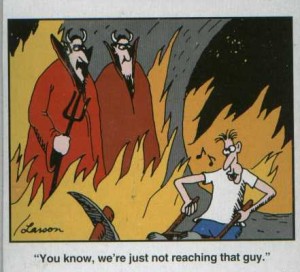I’m a pragmatist.
One of my strengths is that I can take a big, lofty idea (usually conceived by someone else), and help bring it down to earth. Break it down into reality, make it happen. Tamsen excels at that, too. (The blog’s tagline here is no accident). So for most purposes, I’m pretty practical, and I’m sometimes the killjoy as a result.
But I’d like to say something.
I’ve been in the business world for nigh on 15 years now. I’ve worked in nonprofits and the corporate world, mostly in communications roles like fund development, marketing, client services. I’ve seen little business, big business, slow business, and fast business. I’ve experienced bringing the web into the business world, and all that’s entailed (for better or worse). I’ve watched a lot of stuff change, and a lot of stuff stay the same.
In the 3 years or so that I’ve been working in and around social media specifically, I’ve seen some amazing things happen. I’ve been in awe of the implications, the changes, the subtle shifts (and the not so subtle) that have been happening in the way we communicate with one another, be it business or personal.
And I’m still excited.
I know negativity sells. Controversy catches eyes, and it’s all the rage right now to, well, rage against the machine that is social media. Or point out all its shortcomings. Or declare things or people dead, over, overhyped. Or spend time tearing ideas down instead of applying true critical thinking, and figuring out how to build something from the rubble.
But I just don’t think that’s very helpful.
We are indeed at a time of unprecedented opportunity. The web and its agility give voices where there were none, ways to connect that defy time and geography, opportunity for ideas that might never have seen the light of day. It’s helping businesses rethink everything from their culture to their people to the systems they’ve built, and even big ships are finding themselves turning in new directions.
And we’re starting. We’re trying. We’re learning with little things that feel comfortable and familiar (and don’t always go so well, but that’s the nature of progress). There are missteps and misunderstandings and lots of imperfections, but those will always be there. The nature of a gawky adolescent with limbs too long and a mind too easily distracted.
But we are moving. Waking the sleeping giant. Growing and maturing with flashes of brilliance amid our zealousness. And things are indeed changing around us…for good.
I think that’s pretty spectacular. We’re part of history right now, and not an insignificant part. To all of you with enthusiasm and knowledge, I say let’s leave people with things they can do. Focus some of our boundless energy into the hard work of creating, of criticizing with thoughtfulness and progress in mind, and laying a foundation upon which we can build this next generation of human connectivity.
I still believe. Do you?
Amber Naslund
photo credit: Bob Jagendorf

 It is good to hear senior marketing people beginning to talk turkey about online demand generation now that some of the luster and magic has worn off of social media. And while both customer behavior and online tactics have evolved, the essence of good online demand generation has stayed the same for the past decade; and really its boils down to 5 key factors to sustainable success online.
It is good to hear senior marketing people beginning to talk turkey about online demand generation now that some of the luster and magic has worn off of social media. And while both customer behavior and online tactics have evolved, the essence of good online demand generation has stayed the same for the past decade; and really its boils down to 5 key factors to sustainable success online.
